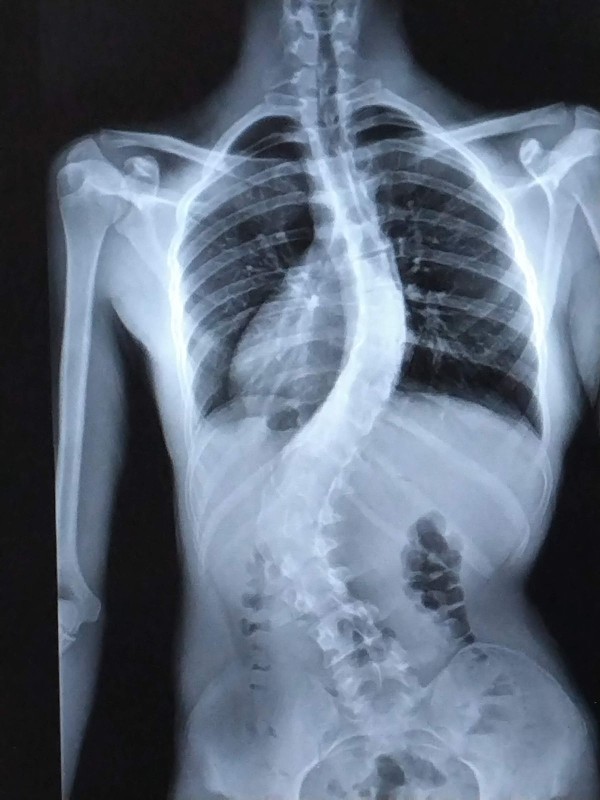 Watching Collin Vaughn exercise in the gym today, you’d never know he’d undergone serious back surgery.
Watching Collin Vaughn exercise in the gym today, you’d never know he’d undergone serious back surgery.
“There isn’t a thing out there that stops me. When I got the scoliosis diagnosis, I had to rethink how I was going to live life. But you can’t give up,” said Collin.
That mental strength helped him while facing his adolescent idiopathic scoliosis (AIS) treatment. AIS is a curving of the spine that occurs during puberty. Telltale signs of scoliosis are uneven shoulders, an elevated hip, a prominent shoulder blade, a shift of the body to the right or left, or a hump in the back when the child bends forward. In Collin’s case, he had a curve in the upper and lower portion of his back, giving him a visible “S” shape.
If scoliosis is left untreated and the curve worsens, significant deformity and back pain may result. Untreated patients with severe curves may show evidence of heart and lung disorders later in life due to compression of the chest.
After being diagnosed, his family did additional research and decided Collin should be treated by Lindsay Crawford, MD, a pediatric orthopedic surgeon affiliated with Children’s Memorial Hermann Hospital.
“Collin’s family already knew surgery was the most likely treatment for his scoliosis. However, it’s important that all patients are educated about the full scope of treatment options,” said Dr. Crawford.
Treatment options can include monitoring the curve, bracing and physical therapy, or surgery. Pediatric orthopedic specialists make treatment decisions based on the potential for progression, which depends on three things: skeletal maturity (age), curve magnitude and location of the curve. Because Collin’s spine was already curved greater than 50 degrees in two places, Dr. Crawford and his family agreed posterior spinal instrumented fusion was the best option for Collin.
“Patients with adolescent idiopathic scoliosis may be living life normally and without pain. However, the bigger the curve, the bigger the threat to the heart, lungs and spine in the future,” said Dr. Crawford. “We want to make the appropriate treatment decisions now so that these adolescents can have full lives into adulthood.”
Collin underwent surgery at Children’s Memorial Hermann Hospital in the summer of 2023.
During the surgery, screws are inserted into the spine, acting as anchors for rods that help correct the spine’s curvature. To enhance precision, Dr. Crawford and the affiliated team utilized a specialized table at Children’s Memorial Hermann Hospital that is connected to a cutting-edge imaging device capable of generating a 3D representation of Collin’s spinal structure.
"Utilizing the 3D representation and navigation, we’re adding another level of safety to a delicate procedure,” said Dr. Crawford. “It allows us to determine where to best place the screws to make sure we’re not risking injury to the spinal cord or nerves that are close by.”
The surgery normally takes six to eight hours. Dr. Crawford says many patients, and families, are surprised to learn they will be getting out of bed the next day.“We have spent a lot of time with our teams discussing post-operative care. We provide extra education about scoliosis patients and our physical therapy teams are skilled to help them get out of bed safely. The affiliated pediatric anesthesiologist team is also there for pain control issues. They utilize multimodal medicine, meaning several different classes of pain medication, to make sure our patients are comfortable after surgery,” said Dr. Crawford.
Collin’s family also had access to Children’s Memorial Hermann Hospital’s specially trained spine patient navigators. “We have a patient navigator specifically for our spine and scoliosis team and that has been amazing.The navigators work with the families before, during and after surgery to help answer big and small questions and guide them through the entire care plan,” said Dr. Crawford.
Collin says the staff at Children’s Memorial Hermann made him feel very supported. “The nurses were phenomenal.”
Dr. Crawford cleared Collin for regular activity six months after the surgery and physical therapy.
“I thought putting metal inside of me would have destroyed my life, but it didn’t. While doctors tell you the surgery will go great, recovery is a mystery. That’s what was hardest for me. So, I would tell people, the more you care about your recovery, it helps speed up your process. If you blow off PT, if you don’t do the things the doctor tells you to do, you’ll never get better,” said Collin.
“Collin did amazing and had a great attitude throughout the process which really aided in his recovery,” said Dr. Crawford.
Collin’s father, Dean, acknowledges the seriousness of Collin’s conditions and knows it can be scary for parents. He’s thankful they chose Children’s Memorial Hermann Hospital and the affiliated pediatric orthopedics and scoliosis team.
Dr. Crawford reminds families that treatment for scoliosis can be a nuanced decision, so it’s important to have thorough conversations with their care team before making the decision that’s right for their child.
“It’s a balancing act. Thankfully, there are operative and non-operative options, and with proper monitoring, the timing of a potential surgery can be aligned with the family’s schedule to prevent disruption to other important things, like school. Every patient and family are a little bit different and we want to help ensure the best possible outcome,” said Dr. Crawford.
Collin recently graduated high school and is preparing to go to trade school for welding.
“I believe if you have a dream or a hobby, there shouldn’t be anything that can stop you,” said Collin. “Working with my hands helps me focus my mind, and I’m excited about my future.”
Contact Us
To contact Children's Memorial Hermann Hospital, please fill out the form below.
If you are experiencing a medical emergency, call 911 or go to the nearest emergency room.
If you or someone you know needs support from the Suicide and Crisis Lifeline, call or text 988.